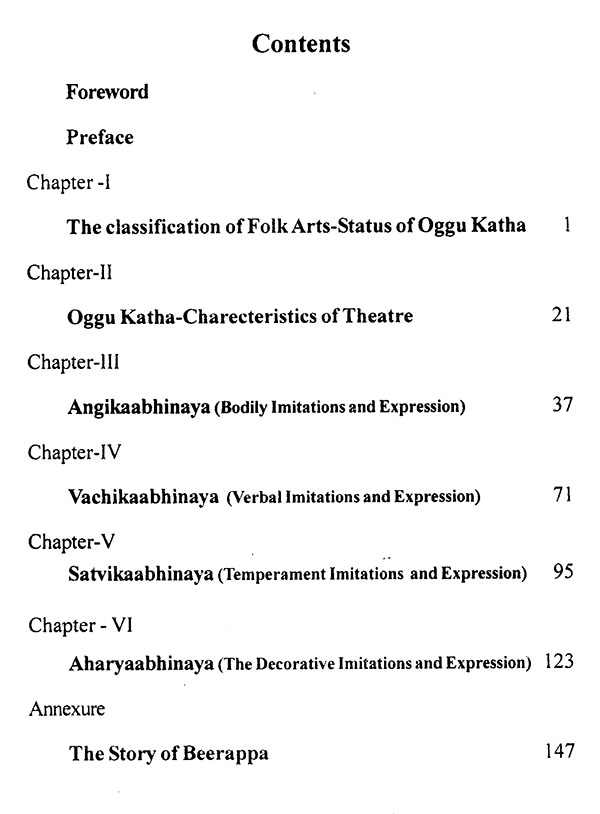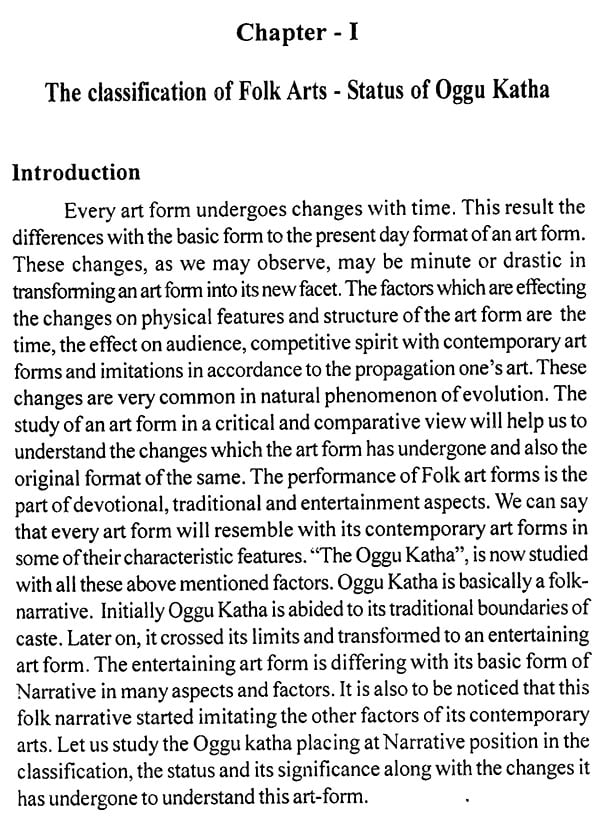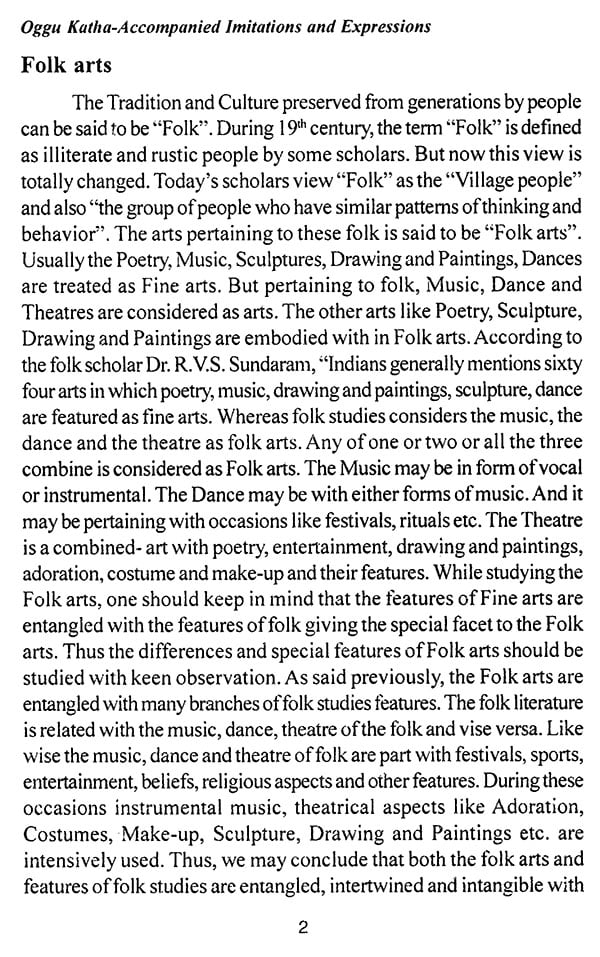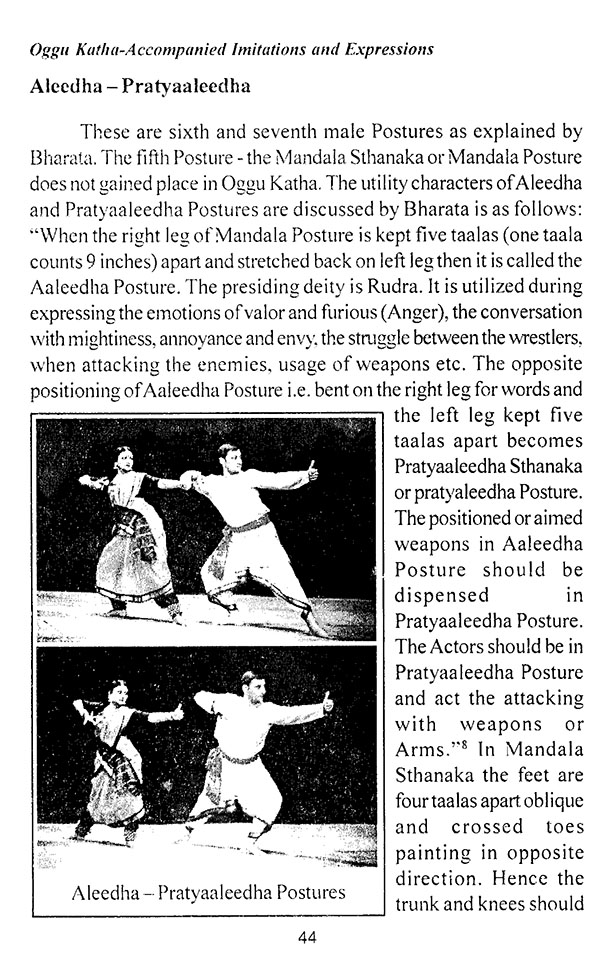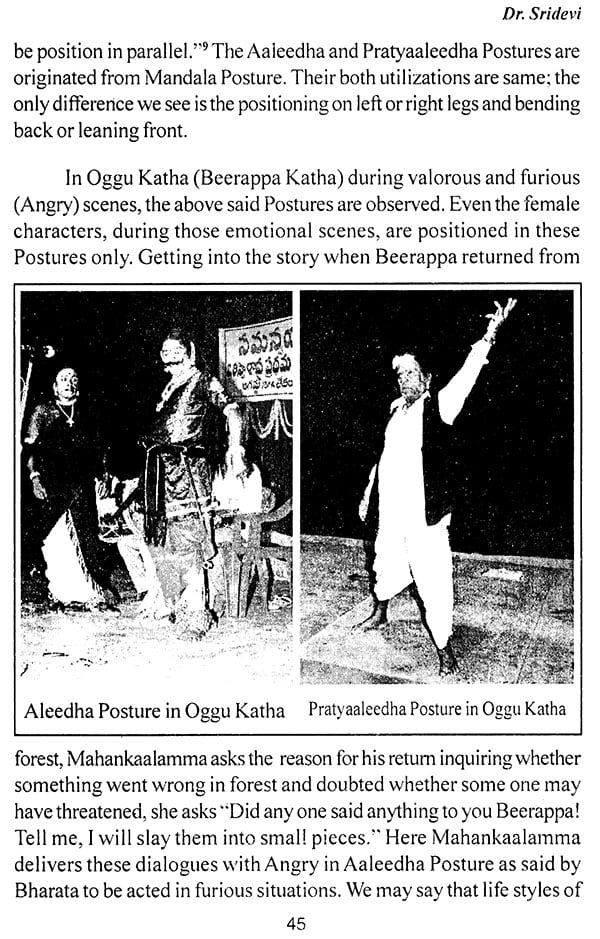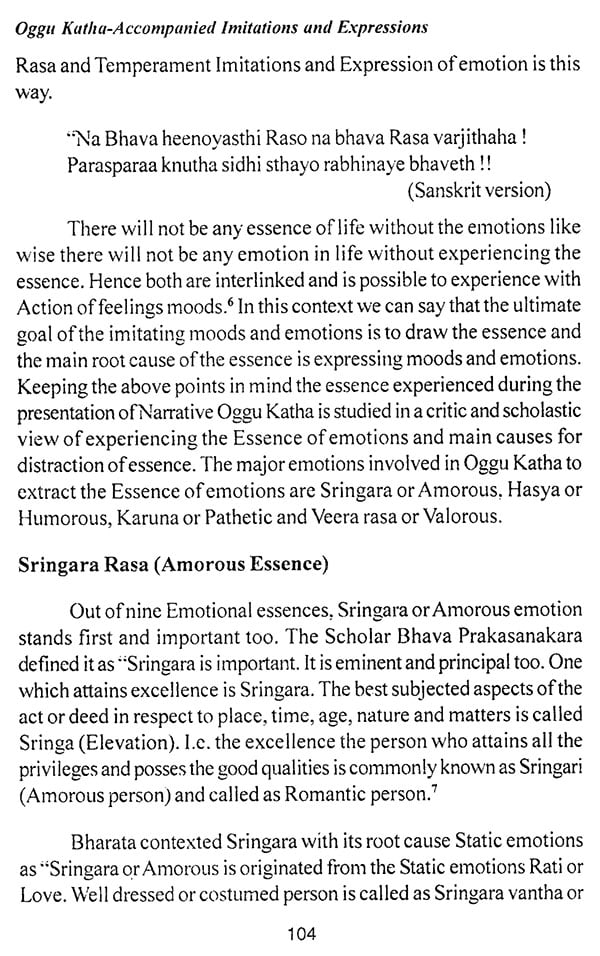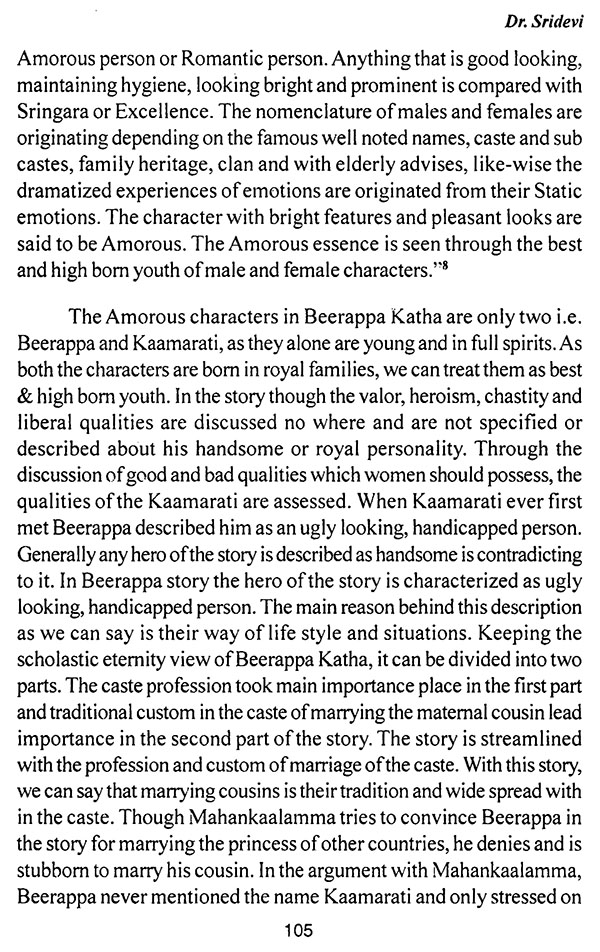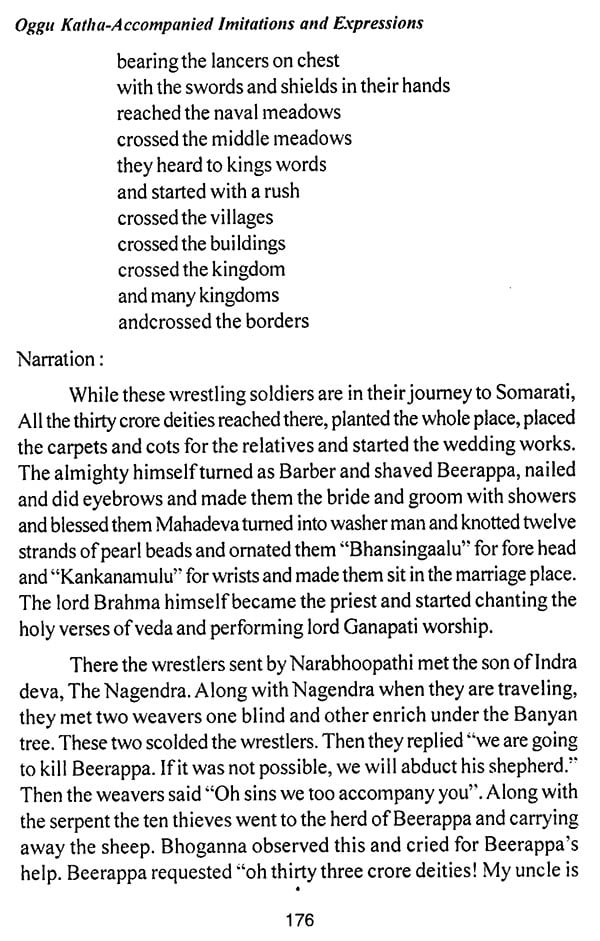
Oggu Katha - Accompained Imitations and Expressions
Book Specification
| Item Code: | NAX075 |
| Author: | R. Vasudev Singh and Sridevi |
| Publisher: | Dravidian University Campus |
| Language: | English |
| Edition: | 2011 |
| ISBN: | 9789381112243 |
| Pages: | 180 (30 B/W Illustrations) |
| Cover: | PAPERBACK |
| Other Details | 9.00 X 6.00 inch |
| Weight | 240 gm |
Book Description
Dr. Vasudev Singh M.A., M.Phil. Ph.D., is scholar of out standing merit throughout his career. He was Awarded Gold Medal for his Doctorate research work and also awarded Senior research fellowship from Ministry of Culture, Government of India. His present occupation is Choreography. He presented many research papers in National and International seminars. Many of his articles on Arts were published in different Journals and Magazines. His scholastic view of compiling Arts lead to four publications.
Dr. Sridevi, B.Sc., M.A., (Kuchipudi Dance), Ph.D., (Folk Arts) is multi talented. She is a Dancer, Choreographer, Scholar and Translator. Her natural enthusing Toward Arts turned her personalities as a scholar. She presented papers in many National and International Seminars. She Published a publication on South Indian Opera Theatre — Yakshaganam. As a translator she helped many well known foreign Scholars in their research work.
Dravidian University was established in 1997 to mirror the real and rich picture of Dravidian culture not only in its linguistic, litracy,culture and philosophical faces but in science and technological angles also.
The sprit of integration is the guiding force behind the creation of the University. The linguistic and cultural integration, not only at the regional but also at the national level is the cherished objective of the University.
The Government of Andhra Pradesh started Dravidian University, with the co-operation of the sister states, to reach and research and reflect on the inherent oneness of the cultures of Dravidian family of the four States whose languages number up to 27. Its endeavour is to promote unity and amity in the family of several languages. The main objectives of Dravidian University are to augment the common weal and social well being of the communities of marginal languages and to built bridges among the Southem states. While working on each language separately in varied areas, it aims at synthesis and a discovery of the common heritage through Comparative Studies.
Oggu katha is the traditional Folk art-form of Telangana region of Andhra Pradesh with rituals and customs. It pertain both the traditions and entertainment aspects. Though it is a ritualistic performance of a Particular caste i.e. Kuruma, it is positioned in special category of entertainment after its transformation. Such types of ritualistic Traditional art are becoming basement to the arts of India projecting the unity in diversity.
Such type of rituals are also featured in Oggu Katha. Not only had this Oggu Katha also sustained its position in this modern competitive world of audio-visual entertainments. It is imbibing the psychological and moral strengths in the depending castes and becoming supportive to gain the four conceptuals namely Dharma, Artha, Kama and Moksha therefore justification, financial assertiveness, wants and eternity. The story of oggukatha is about beerappa belonging to Kuruma caste. The main streamline of this Oggu Katha is based on the epical story of incarnation of Beerappa. It is their traditional custom to perform this art form during the occasions of rituals, festivals and for attaining their wishes. Now, this story crossed its boundary limitations of customs and traditions became widespread, attaining entertainment aspects and positioned in an special category. Oggu katha, though once been a regional art, being crossed some rules of customs and traditions, became a universal art form.
Generally, folk art forms differ from the Classical art forms. They are extraordinary and wonderful without following any rules and regulations. Oggu katha is a Folk narrative consisting special music and narrative styles. Though the base of the story is depiction, the narrator narrates it with trends of theatre (Imitations and Expressions). Comparing the traditional oral narrating art form Oggu katha with the theories and trends of the Classical theatre is the special feature of this book. Each and every aspect of Oggu Katha is studied and compared with the characteristic features, theories of dramatology to present the differences and common features.
It is praise worthy to study this art form which is still holding its position in the competitive world of digitalized arts. To study the Traditional art form in these changing trends of education and the interest of Author in it is to be appreciated. Along with this, propagating the basics and primary aspects of this art is also laudable. Here, in his book, the author wants to propagate the facts and features of this Folk art to the world.
It congratulate Dr. Vasudev Singh for his detailed study on the ignored facts of Oggu katha. I also congratulate Dr. Sridevi for her fair translation of the book in English in the name of Dravidian University.
Today the study and research works in the field of folk are done more around world wide. Many Western folklorists proposed theories which resulted from their scholastic studies and researches. If we observe the folk research studies in Telugu language, the major work is contributed through the literature branch by linguists and folk lore authors. Their contribution are seen not only in form of the gathered material of folk stories, songs, riddles, tongue twisters, quotations, conundrums, proverbs etc., but also touched the folk art forms. It is not exaggerated fact that most of the folk art forms are explained and discussed by the linguists. Some of them also compared our Telugu literary works on folk aspects with those of Western folk theories proposed. But considering the folk art forms as main subject and aiming to its deep study is rarely done. Now-a-days only the research works on those art forms are leading prominence. The research study on art forms in view of an artist will completely differs with the view of others. We may say that the other scholar may touch only the external features of an art form whereas the artists, not only studies the external features but also touches the internal aspects keeping in mind such as the view of production of story, performing aspects etc., The self experience of performing an art form to an artist helps him to study different aspects of subject in different angles and study it thoroughly. If we study with this view, the nature of art form and its performance can be easily understood. Even the western folklorists proposed the theories of the art forms with presentation aspects and their features. To characterize the main features of art forms should be the main goal of such studies. According to my opinion all art forms can not be featured or characterized with the theories proposed by the Western folklorists.
Especially, if we take the Indian folk art forms into consideration, there will be a lot of difference between its present way of performance and its originated form. Initially they were all abided to the traditions with some rituals and trends. Gradually, they modified to the entertainment arts and led to diverse in its structural features. With the proposed western folk theories one can only able to study the physical features of an art form, but cannot touch their ground levels. Mostly the physical characteristic features of a folk art form will be performed differently depending upon the psychology of an artist and showers diversity from artist to artist; where as the main notes of the folk art will be unique. So, studying the art forms reflecting our cultural heritage and Traditions with proposed theories of west is always interrogative. Ifthe art forms are said to reflect the routine life style of the folk, then studying the art forms reflecting the Indian habit, habitats, life styles with proposed folk theories and analyze them is always doubtful. This dilemma motivated to do this study. So, to study the art forms of Indians with an Indian psychology and its theories of science of drama is considered instead of proposed western theories.
‘Natya Sastra" is the great literary work done on Indian arts. Though this literary work is always linked with the Classical arts and its science is discussed linking with the world wide ways of psychology and human behavior tendencies. The Sanskrit word Sastra means science. The science of theatre or Natya is Natya Sastra. Though the science declares, commands, codifies the theories to be followed. Here in case of Natya Sastra, it doesn’t command but prescribed various aspects of importance to be followed by the theatre correlating with the world wide ways. Even though the period of Natya Sastra is of two thousand years dated back, still its aspects discussed correlate today’s worldly affairs of human tendency and psychologies 1.e. world wide ways. Taking all these aspects of Natya Sasira into consideration and want to compare with a folk art form instead of classical, the Oggu Katha is selected for a comparative study.
Oggu Katha initially is a Traditional art form performed with in the limits of its caste slowly traversed in an entertainment path and transformed into Non-traditional entertaining folk art form occupying the theatrical dais.It is said that the artist plays a key role in changing the path, direction and features ofan art forms, and then in particular with Ogeu katha, Narrator Chukka Sattaiah’s name should be mentioned. Here Chukka Sattaiah played his key role and succeeded in traversing and transforming the narrative Oggu Katha.
Initially, though he faced many problem from his caste, his success in transformation of Oggu Katha to entertainment and placing in equal stature with other forms, He became a guide and venerable with in his caste. So, taking this artist into main consideration, Oggu Katha is studied in different aspects of tradition, imitation, the effect of time, scientific values, social aspects etc., This study is done neither to minimize the classical values of Natya Sastra with foik narrative Oggu Katha nor to equalize the Oggu Katha with Natya Sastra. The study of Ogegu Katha is purely done by keeping in view of the world ways specified in Natya Sastra and the developments or changes take place in any art form with effect of time, especiaily, the folk art form which is also specified in Natya Sastra.
